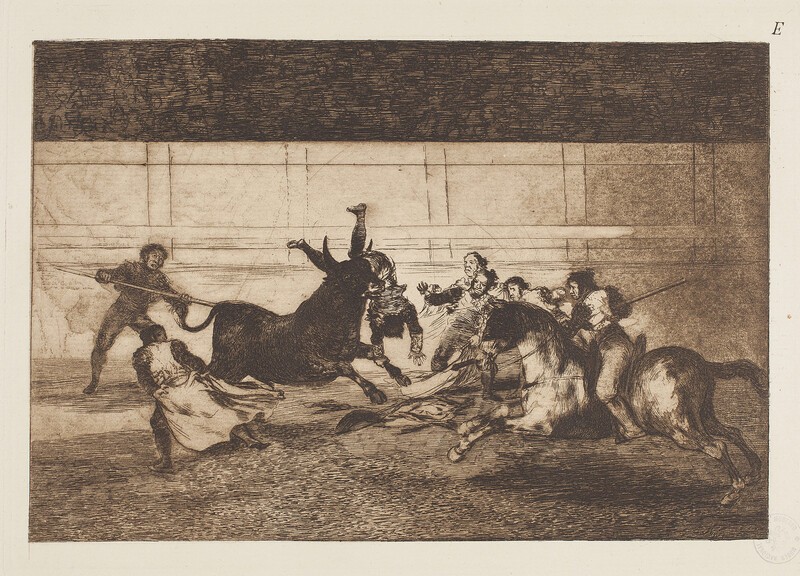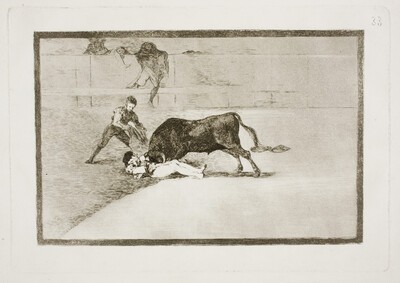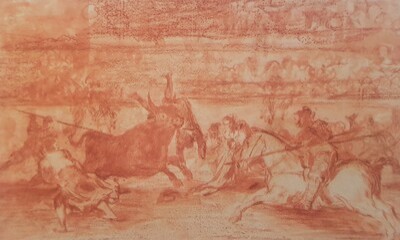- Cronología
- 1814 - 1815
- Dimensiones
- 252 x 347 mm
- Técnica y soporte
- Aguafuerte, aguatinta, punta seca, buril y bruñidor
- Reconocimiento de la autoría de Goya
- Documented work
- Ficha: realización/revisión
- 01 Oct 2021 / 22 Jun 2023
- Inventario
- -
E (print, upper right-hand corner)
Goya (print, bottom right-hand corner)
See How the ancient Spaniards hunted bulls on horseback in the countryside
The print, rejected by Goya and not included in the first edition of the Bullfighting of 1816, was added and published for the first time, along with six other (A-G), in the third edition of the series, published by Eugène Loizelet in Pais in 1876. It was retained in subsequent editions of the Bullfighting .
A condition test is retained before additional burnishing and letter insertion.
The plate of the print is preserved in the National Chalcography (no. 371), with The Cid Campeador spearing another bull engraved on the obverse.
See How the ancient Spaniards hunted bulls on horseback in the countryside
The title of the print was established by Loizelet in 1876 when he included it in the third edition of Bullfighting. Harris does not quite understand why he gave it that title, although a close look at the scene reveals that it corresponds to the fatal goring of the famous bullfighter Pepe Illo (1754-1801), which took place on 11 May 1801 in the Madrid bullring. It depicts the moment when the bull charged Pepe Illo in the thigh and lifted him up into the air. As a result, he fell to the ground and was impaled in the stomach, a wound which ended the life of the bullfighter twenty minutes later in the infirmary of the bullring in Madrid.
This is a very dynamic scene, with a lot of movement, in which the bull is on fire and has the bullfighter hanging upside down with his left leg, while in fornt of the bull a bullfighter on horseback is ready to attack the animal to make him release his prey. Next to him, four peons watch the scene with anguish and nervousness and it seems that, with their capes, they try to separate the bull from the bullfighter in a disorderly fashion. Behind the bull, another peon attacks the animal with a pike in an attempt to get him to let go of the bullfighter.
Beruete points out that the print has a defect in the aquatint bite that can be seen on the left of the composition and which causes several stains, a defect that, in Hofmann's opinion, led Goya to discard the engraving. Hofmann analyses the work symbolically, pointing out that two forces confront each other: evil (the black bull) and good (the white horse). Lafuente Ferrari, for his part, emphasised Goya´s faithfulness in continuing to narrate the death of Pepe Illo and doubted the authorship of the preparatory drawing. Luján comments on the composition of the scene and stresses the movement that characterises it, while Martínez- Novillo, after reaffirming that what is depicted correspond to the fatal goring of Pepe Illo on 11 May 1801, agrees with Lafuente Ferrari that the copper was discarded and reused due to a technical defect.
Goya engraved two other scenes capturing different moments of the fatal goring of the famous bullfighter Pepe Illo: the one he ended up including in the first edition of Bullfighting , entitled The Unfortunate Death of Pepe Illo in the Bullring in Madrid, and a third which he also discarded, entitled The Death of Pepe Illo ( Bullfighting F).
It is also worth noting that Goya dedicated another print in Bullfighting to Pepe Illo, very different from the previous ones, as it focuses on his great skills as a bullfighter although it also alludes to his tendency towards recklessness: Pepe Illo cutting the bull.
There is a preparatory drawing of this print, also titled The Death of Pepe Illo (Bullfighting E)
-
Grabados y dibujos de Goya en la Biblioteca NacionalBiblioteca NacionalMadrid1946catalogue Elena Páez Ríos
-
Goya en la Biblioteca Nacional. Exposición de grabados y dibujos en el sesquicentenario de su muerteBiblioteca NacionalMadrid1978May - June 1978
-
Grabados de Goya: colección propiedad de la Biblioteca Nacional, que se conserva en su Gabinete deCasa de la Amistad de MoscúMoscow1979exhibition displayed from January 18th to 31st 1979
-
Goya. Das Zeitalter der Revolucionen. Kunst um 1800 (1980 – 1981)Hamburger KunsthalleHamburg1980cat. 258
-
1984
-
Madrid1987
-
Goya: toros y torerosEspace Van GoghArles1990displayed also at Academia de Bellas Artes de San Fernando, Madrid, consultant editor Pierre Gassier.cat. 54
-
Goya grabadorFundación Juan MarchMadrid1994consultant editors Alfonso E. Pérez Sánchez and Julián Gállego, from January 14th to March 20th 1994
-
Goya grabadorMuseo del Grabado Español ContemporáneoMarbella1996from March 8th to May 5th 1996
-
Ydioma universal: Goya en la Biblioteca NacionalBiblioteca NacionalMadrid1996from September 19th to December 15th 1996cat. 268
-
Schlaf der Vernunft. Original radierungen von Francisco de GoyaMunich2000
-
Madrid2002
-
Madrid2002
-
Bilbao2012
-
Zaragoza2017
-
ViennaGesellschaft für vervielfältigende Kunst1907cat. 119
-
MadridBlass S.A.1918pp. 138-139
-
1946pp. 177-216, espec. pp. 211-212
-
BarcelonaTartessos-F. Oliver Branchfelt1946 (reed. 1951)
-
OxfordBruno Cassirer1964vol. II, 1964, p. 355, cat. 241
-
Vie et ouvre de Francisco de GoyaParísOffice du livre1970p. 280, cat. 1227
-
The Changing image: Prints by Francisco GoyaBostonMuseum of Fine Arts1974pp. 244-247, cat. 197-198
-
Goya, Das Zeitalter de Revolutionen. 1789-1830HamburgPrestel-Verlag Münche und Hamburger Kunsthalle1980p. 294
-
MilwakeeMilwaukee Art Museum1986pp. 19 y 28
-
Goya, toros y torerosMadridMinisterio de Cultura, Comunidad de Madrid1990p. 116, cat. 54
-
MadridCaser-Turner1992pp. 37 y 39
-
Catálogo de las estampas de Goya en la Biblioteca NacionalMadridMinisterio de Educación y Cultura, Biblioteca Nacional1996cat. 364
-
Ydioma universal: Goya en la Biblioteca NacionalMadridBiblioteca Nacional, Sociedad Estatal Goya 96 y Lunwerg1996pp. 242-243
-
MadridMuseo Nacional del Prado2001pp. 103-104





